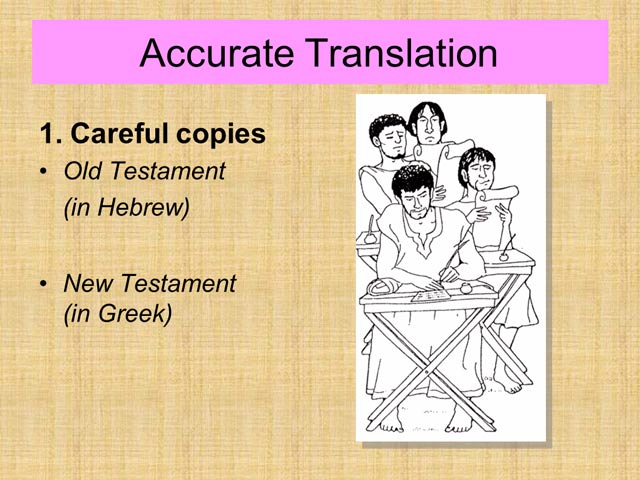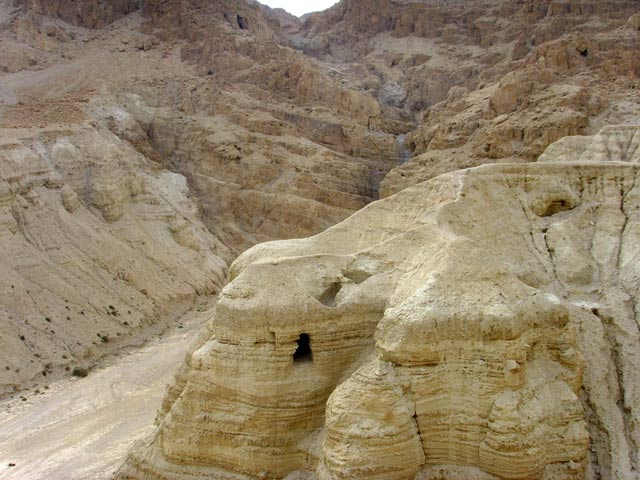How do we know that the Bible we have today a faithful translation of the original manuscripts?
Critics have said: “Even if you have proved that God inspired the original writers, how can you be so sure that the modern Bible is a translation of the actual words of the original documents?”
When God first spoke to the Bible writers, they wrote down God’s messages in their own languages – mainly Hebrew and Greek. These original documents have since been translated into different languages.
We can be sure that the translations are faithful, because the original manuscripts were copied with enormous care.
This post is part of a series on the Bible
♦ 2 Reasons To Believe The Bible: Its Harmony and Accurate History
♦ Another Reason to Believe the Bible: Its Accurate Science
♦ A Further Reason to Trust the Bible: Its Accurate Translation – This post
♦ Evidence that the Bible is Inspired by God: Fulfilled Prophecy
♦ More evidence that the Bible is Inspired by God: Its Miraculous Protection
♦ Why the Bible is worth reading today: Its Relevance and Supernatural Impact
♦ What is in the Bible and Why?
♦ The Books Not in the Bible : The Apocrypha and Gnostic writings
Original manuscripts were carefully copied

The Old Testament
The copies of the first Hebrew Scriptures were hand-written by men called scribes (hand-writers). That is why the Bible came to be called ‘The Scriptures’ (hand-written).
To make absolutely sure that a copyist had made no mistake, he would count every letter of his copy and check if it was the same as the number of letters in the original. Then he would check the middle word and the middle letter of that word, to see if it was the same as the original document. Only then was the copy passed as accurate.
That way, when further copies were made from that copy, and checked in the same way, there was no chance of mistakes being added in and copied, down the centuries.
The New Testament
The Greek New Testament was also copied by hand. But, because many people wanted copies, many scribes got together to work at the same time. The Chief Scribe would read out from the original and a group of scribes would write it out.
Today we have about 5,000 Greek manuscripts of the New Testament, mostly copies made within 100 years of the original, and some fragments were only 50 years from the original.
There are far more copies available to check the accuracy of the New Testament than of other writings of that time.
Bible manuscripts versus Tacitus
The history books of Tacitus, for instance, were written in 100 AD. But the earliest copy available is from 1000 years later.
We have over 5,000 Greek manuscripts of the New Testament, but there are only 20 copied manuscripts of Tacitus today. Yet this does not stop him being generally regarded as a fundamentally accurate and appropriate historian.

Can copies of copies be trusted?
The best translations of the biblical manuscripts were made directly from the original Hebrew and Greek, rather than simply improving someone else’s translation. But some people still said: “The old documents you are using are copies of copies. They must have many mistakes.”
So Bible scholars wanted to find a really old copy, one of the earliest to be made, so they could check it against the later ones from which our translations came, and prove them completely accurate.
This did indeed happen. Here’s how…
Goats and scrolls

Old Testament scrolls
A group of Essenes (a Jewish sect) were living near the community of Qumran, in the region of the Dead Sea. It was at a time when the Roman army was searching for, and destroying, Jewish settlements and writings.
Afraid that their library of precious Scripture scrolls would be destroyed, the Essenes stored them in clay pots and hid them in caves. It was hundreds of years later that a goat-herd passed by.
His goats had wandered off. He looked up at a ledge in the rock face, but could not tell if the goats were there or not. So he threw a stone to startle the goat into appearing. To his surprise the stone disappeared and he heard the sound of breaking pottery. The stone had gone right into a cave. Clambering up, the goat-herd found rows of clay pots, containing the scrolls.
Archaeologists agree these were the oldest copies of the book of Isaiah that they had ever seen. Now they could check if later copies were any different from these. They would learn if the newer versions had all the mistakes they expected!
In all the 66 chapters of Isaiah there were only 13 differences, mostly simple spelling mistakes.
So translations of the Old Testament made from even later copies have still been very accurate.
New Testament scrolls
Much earlier, in another settlement, situated on Mount Sinai, New Testament scrolls were found. They were so old that it is thought that they were the first copies made from the originals. Once again, they matched the later copies exactly!
These and other ancient manuscripts have proved that more recent versions of the Bible are accurate translations of the Bible originals.
All the evidence points to the historical and scientific accuracy of the whole Bible, and of its later translations.
There may still be parts which, to some people, appear to be mistakes. But as our understanding of past history, and science, and ancient languages improves, we become able to explain these seeming difficulties.
This is why Christians trust the Bible to be accurate and truthful.
Free PowerPoint presentation
There is a PowerPoint which you can use to review or teach the contents of this post. It is accompanied by full notes with cues for advancing the slides.
Please note: The teaching of this post is bundled into one PowerPoint with another post on biblical science .

Right-click on these links and save the files to your computer.